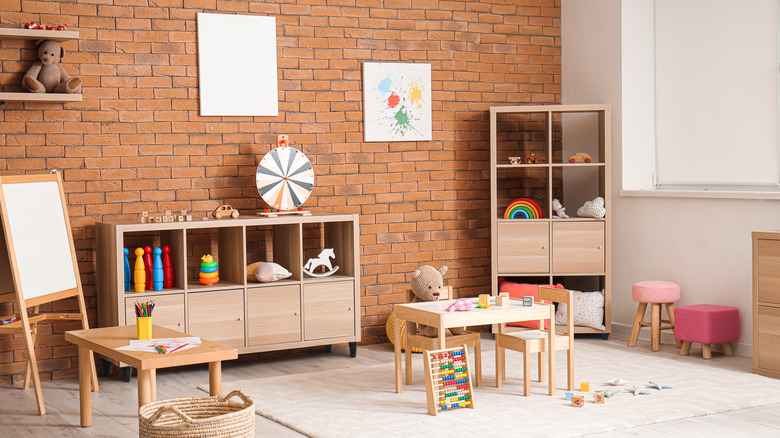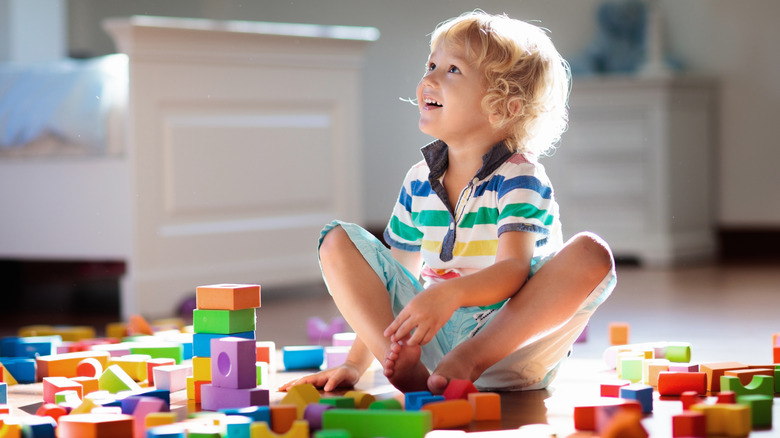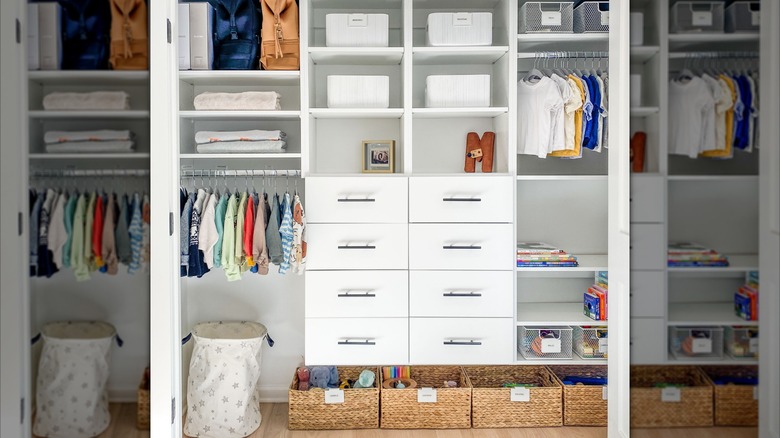Our Expert Says Joanna Gaines' Playroom Storage Recommendation Isn't For Everyone
Joanna Gaines was still pregnant with her youngest son, Crew, when the popular home decor guru made a controversial design choice on "Fixer Upper." During Season 5, she worked with a couple who wanted to create a unique playroom for their grandkids that would continue to inspire and grow with them as they got older. The result was a bold space with navy blue built-in bookshelves, a reading nook with aged wood paneling, green turf flooring, and tree stump seating. Gaines said the playroom, with its whimsical forest theme, ended up being her favorite spot in the house. The controversial choice? Tons of closed cabinets to hide games and toys.
We spoke with Jamie Hord, founder of Horderly Professional Organizing, in an exclusive interview with House Digest to get her expert opinion of Joanna Gaines' playroom storage choice to keep the kids' clutter hidden. "I think this works for some people and doesn't for others," she explained. "I personally love this concept and believe that everything can have a place concealed away. Too much visual clutter (even for kids!) can be overwhelming and cause them to play less with their toys. Some people, however, need to visually see things to remember [they have them] and this works better for them." Hord went on to suggest one middle-ground solution of using clear bins inside cabinets. Many popular products to keep a house organized with kids are transparent, and make it easy to find those favorite plushies and puzzles when kept at eye-level.
Both playroom storage options have pros and cons
In her exclusive interview with House Digest, Jamie Hord said she could understand Gaines' inclination to reduce visual clutter with closed cabinets in playrooms. Fewer toys out at once can be more fun and engaging for some children, but she cautions that there are some major disadvantages of using closed storage to keep toys and games organized. It's a more expensive solution, especially if you need to build your own cabinets. Hord also raised concerns about parents — and kids — simply forgetting about what gets shoved into drawers or into the back of cabinets. "Out of sight, out of mind," she reminded parents.
Hord said the major advantage of using an open storage option to organize a playroom is that it's easier to remember what toys and games you have on hand. The disadvantage of this approach is that it does little to conceal the visual clutter that can be overstimulating for the whole family. Kids may find it harder to concentrate when all of their toys are right out in the open. And, if you're trying to achieve a certain aesthetic in your home and colorful blocks or plastic toys aren't a part of your vision, open storage isn't an ideal choice for you.
The most important steps when organizing your playroom storage
Fortunately, there are other ways to keep a playroom tidy. "We love using cabinets with bins inside to organize and store toys in a playroom," Jamie Hord explained in her exclusive interview with House Digest. "We also love using a cubby system with cube bins and drawers." Hord had more tips for overwhelmed parents. "Toy rotation is key," Hord emphasized. "Store half of the toys you have and rotate them consistently. This will keep kids entertained and interested in their toys."
The professional organizer also advised that whether or not you opt for closed cabinet storage, you should regularly declutter. It's always the very first step in Horderly's process, before developing organizing systems or beautifying a space with closed or open storage cabinets. "Keep the 1-in-1-out rule in mind, getting rid of something old when something new comes in," she said. "This will help your space stay maintained." Hord also recommended labeling storage cabinets, cubes, bins, or baskets so everyone knows where items belong. "Keep up with daily cleaning routines and have the kids help you put toys away before nap and before bed," she added.


